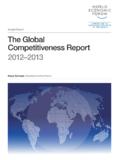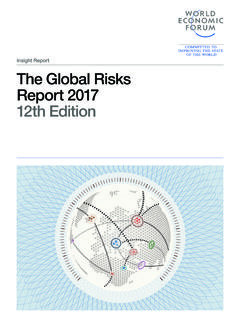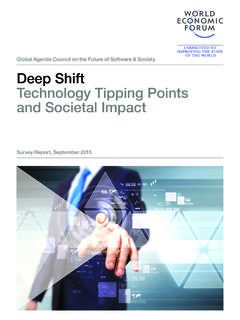Transcription of COMMUNITY PAPER SEPTEMBER 2021
1 Navigating Cryptocurrency Regulation: An Industry Perspective on the Insights and Tools Needed to Shape Balanced Crypto RegulationCOMMUNITY PAPERSEPTEMBER 2021 Global Future Council on CryptocurrenciesContentsExecutive summary1 Cryptocurrency What is a cryptocurrency and a cryptocurrency network? What are some characteristics of cryptocurrency networks?2 Regulatory Macro-level and multi-jurisdictional Consumer Infrastructure-specific Key takeaways and guiding principles3 Regulatory opportunities for inclusion and De-risking and its global Addressing financial inclusion and Digital Key takeaways and guiding principles4 Global regulatory Categories of regulatory Legal status of cryptocurrencies around the Guidance from international Key takeaways and guiding principlesConclusionContributorsEndnotes 3455679101213141416161718192425262729 Images: Getty imagesDisclaimer This document is published by the World Economic Forum as a contribution to a project, insight area or interaction.
2 The findings, interpretations and conclusions expressed herein are a result of a collaborative process facilitated and endorsed by the World Economic Forum but whose results do not necessarily represent the views of the World Economic Forum, nor the entirety of its Members, Partners or other Cryptocurrency Regulation: An Industry Perspective on the Insights and Tools Needed to Shape Balanced Crypto Regulation2 Executive summaryCryptocurrencies and the underlying blockchain technology are becoming a pervasive force in the global economy, affecting everything from cross-border retail payments to interbank transfers. The growing adoption and decentralized nature of cryptocurrencies pose unique and unprecedented challenges for financial authorities, capital markets regulators, consumer protection and privacy bureaus, and tax authorities around the world.
3 However, cryptocurrencies also bring opportunities in terms of leveraging the internet to provide new digital pathways for individuals and micro-, small- and medium-sized enterprises (MSMEs) into the global financial system. Further, cryptocurrencies and underlying blockchains contribute a new paradigm for secure data and value transmission, storage and access. As such, the technological and economic particularities of cryptocurrencies require prudent regulation that accommodates the characteristics and use cases of simple terms, cryptocurrencies are digital coins or tokens secured using cryptography. These assets are fully digital; using blockchain or other decentralized ledger technologies (DLTs), they are stored and operate on a decentralized network, with which users can transact directly without the need for a central authority. The assets can be sent instantly at a peer-to-peer (P2P) level, without involving an intermediary such as a bank or central bank.
4 In principle, and in the absence of additional cryptography schemes or failures in security, cryptocurrency transactions are fully traceable and unalterable, and users may remain pseudonymous unless their assets are matched for example, to a validated know your customer (KYC) file through an around the world should develop frameworks to responsibly monitor and guide cryptocurrency activity in their jurisdictions, ensuring, among other things, fair market conduct, market competition, the application and enforcement of tax rules, and consumer protection within the parameters of the assets unique properties, while nurturing the growth of a lucrative cryptocurrency-based economy. At the same time, cryptocurrencies are cross-jurisdictional and, as such, regulatory challenges do not stop at national borders. Regulators should work towards cross-jurisdictional regulatory standards in order to create regulatory clarity, close loopholes and mitigate regulatory arbitrage, while ensuring inclusion of all users is cryptocurrency regulations have been implemented in many jurisdictions, encouraging crypto-based innovations and efficiencies in finance and commerce, particularly for cross-border transactions.
5 Regulators should look at examples elaborated upon in this guide to bolster their understanding of the parameters and variables that are pertinent to the design of regulatory regulatory guide from the Global Future Council on Cryptocurrencies reflects the perspectives of a broad cross-section of the cryptocurrency ecosystem and should be used as a tool to assist financial regulators around the world in developing prudent policies, regulations and ideation to mitigate risks and enable opportunities related to cryptocurrencies. In this guide, we address important themes and considerations for the financial regulation of cryptocurrencies, using insights from the leading authorities on blockchain technology and financial regulators navigating these transformations to the global financial and monetary system. Note: Stablecoins and central bank digital currencies (CBDCs) are outside the scope of this document.
6 The technological and economicparticularities of cryptocurrencies require prudent regulation that accommodates thecharacteristics and use cases of Cryptocurrency Regulation: An Industry Perspective on the Insights and Tools Needed to Shape Balanced Crypto Regulation3 Cryptocurrency basics1 Navigating Cryptocurrency Regulation: An Industry Perspective on the Insights and Tools Needed to Shape Balanced Crypto Regulation4 This section establishes relevant definitions and provides a framework to consider the many issues presented by the purpose of this guide, a cryptocurrency1 is a digital non-governmental asset based on a combination of cryptographic algorithms, whose existence and transfer is confirmed and recorded on a ledger that is distributed across a network of independent computers ( validators ). Before the existence or transfer of a cryptocurrency can be recorded on the ledger, the network s validators must reach agreement according to the network s consensus protocol.
7 The decentralized architecture of the validator network is designed to create trust in the absence of a centralized authority, like a government or other central entity. In a decentralized network, multiple entities operate independently under a network-wide shared governance framework, eliminating the single point of failure or control. This architecture reduces the risk of double-spending,2 while preserving pseudonymity in a transaction. The validators rely significantly (but not exclusively) on cryptography tools to ensure security. For example, cryptocurrency is used as a utility on the network to incentivize (pay) node operators to validate transactions and protect against spam, distributed denial of service (DDoS) and other Cryptocurrencies constitute their own unit of account, although, in most cases, the price to acquire a unit is usually quoted in government-based fiat currency.
8 Additionally, most cryptocurrency projects allow for the issuance of account addresses and the transfer of the currency between sender and recipient, without a centralized party and without the need for personal identification typically required by such are two types of cryptocurrencies: (1) traditional cryptocurrencies, which are created by a standalone blockchain such as BTC (Bitcoin) and ETH (Ethereum); and (2) cryptocurrencies that are digital representations of other assets such as those backed by fiat currency (sometimes referred to as stablecoins) such as USDC issued by Circle. This PAPER is focused solely on traditional cryptocurrencies, which are considered to be mathematics-driven is a cryptocurrency and a cryptocurrency network?What are some characteristics of cryptocurrency networks? are currently thousands of different cryptocurrency projects and networks, many with distinct design, architectures and features.
9 While most cryptocurrency projects rely on a distributed ledger system, there are two primary types of access permission: (1) permissionless, where networks are open and any entity can participate in terms of sending transactions, reading the history (ledger) of transactions, or participating in transaction verification; or (2) permissioned, where participation in these activities is limited by a governance framework that restricts participation. The focus of this PAPER is the former, permissionless cryptocurrency. Additionally, the way networks reach consensus between participant validators is varied; some use proof of work ( BTC), others proof of stake ( ADA) and other Cryptocurrency Regulation: An Industry Perspective on the Insights and Tools Needed to Shape Balanced Crypto Regulation5 Regulatory considerations2 Navigating Cryptocurrency Regulation: An Industry Perspective on the Insights and Tools Needed to Shape Balanced Crypto Regulation6At a macro level, the intersection between the use of cryptocurrencies and the role of commercial banks in delivering monetary services across the globe warrants close attention.
10 From a financial regulator s perspective, current cryptocurrency systems appear to lack features that are critical for sovereign monetary regimes in order to manage and control the financial stability of a country. As cryptocurrencies generally lack an adjustable monetary policy, they cannot respond in the same way to monetary and price stability risks due to shocks to demand for cryptocurrency by adjusting the supply. Similarly, shocks to the supply of cryptocurrency are not mitigated by a monetary authority that could otherwise affect demand to stabilize the price. The capacity to access central banks as the lender of last resort (LOLR) is also not present, potentially increasing the possibility of runs in the absence of a central bank function. Lastly, another concern expressed by central banks is that widely adopted cryptocurrency could potentially weaken a country s monetary sovereignty if fewer people use the domestic unit of account.














